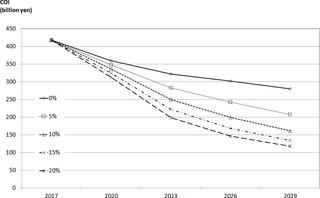PLOS ONE ( IF 3.7 ) Pub Date : 2018-06-19 , DOI: 10.1371/journal.pone.0199188 Kunichika Matsumoto , Yinghui Wu , Takefumi Kitazawa , Shigeru Fujita , Kanako Seto , Tomonori Hasegawa

|
Background
Hepatocellular carcinoma (HCC) is the fifth leading cause of death in Japan. The aim of this study was to calculate the social burden of HCC using the cost of illness (COI) method, and to identify the key factors driving changes in the economic burden of HCC.
Methods
Utilizing government-based statistical nationwide data, the cost of illness (COI) method was used to estimate the COI for 1996, 1999, 2002, 2005, 2008, and 2014 to make predictions for 2017, 2020, 2023, 2026, and 2029. The COI comprised direct and indirect costs (morbidity and mortality costs) of HCC.
Results
From 1996 to 2014, COI trended downward. In 2014, COI (579.2 billion JPY) was 0.71 times greater than that in 1996 (816.2 billion JPY). Mortality costs accounted for more than 70% of total COI and were a major contributing factor to the decrease in COI. It was predicted that COI would continue a downward trend until 2029, and that the rate of decline would be similar.
Conclusions
COI of HCC has been decreasing since 1996. Treatment of patients infected with hepatitis C virus using newly introduced technologies has high therapeutic effectiveness, and will affect the future prevalence of HCC. These policies and technologies may accelerate the downward tendency of COI, and the relative economic burden of HCC is likely to continue to decrease.
中文翻译:

日本肝细胞癌的疾病成本:时间趋势和未来预测
背景
肝细胞癌(HCC)是日本第五大死亡原因。这项研究的目的是使用疾病成本(COI)方法计算HCC的社会负担,并确定驱动HCC经济负担变化的关键因素。
方法
利用基于政府的全国统计数据,疾病成本(COI)方法用于估计1996、1999、2002、2005、2008和2014年的COI,以预测2017年,2020年,2023年,2026年和2029年。 COI包括肝癌的直接和间接费用(发病率和死亡率)。
结果
从1996年到2014年,COI呈下降趋势。2014年,COI(5792亿日元)是1996年(8162亿日元)的0.71倍。死亡率成本占总COI的70%以上,是导致COI下降的主要因素。据预测,到2029年,COI将继续呈下降趋势,并且下降速度将相似。
结论
自1996年以来,肝癌的COI一直在下降。使用新引入的技术治疗感染丙型肝炎病毒的患者具有很高的治疗效果,并将影响未来肝癌的流行。这些政策和技术可能会加速COI的下降趋势,并且HCC的相对经济负担可能会继续降低。



























 京公网安备 11010802027423号
京公网安备 11010802027423号